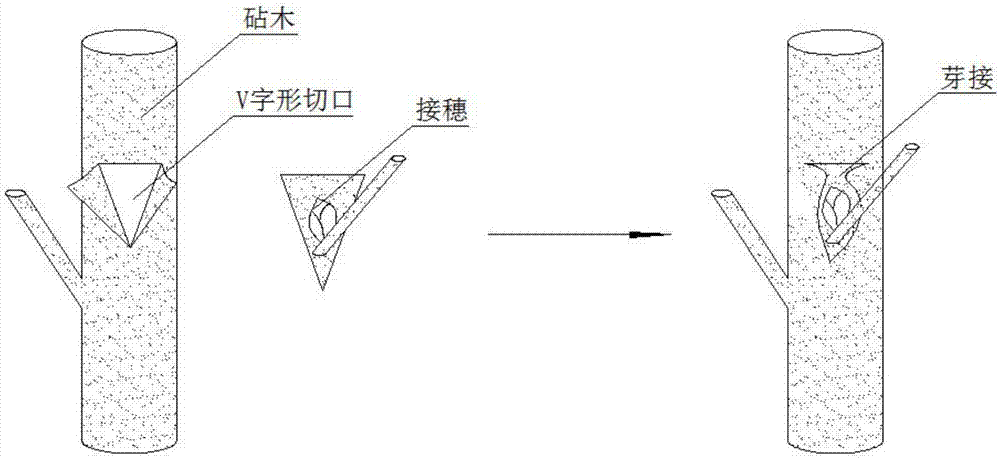Method for grafting loropetalum to redrlowered loropetalum
A technology of safflower following trees and rootstocks, applied in the directions of grafting, botanical equipment and methods, horticulture, etc., can solve the problem of low survival rate of grafting, shorten field cultivation time, improve survival rate, enhance market value and ornamental value Effect
- Summary
- Abstract
- Description
- Claims
- Application Information
AI Technical Summary
Problems solved by technology
Method used
Image
Examples
Embodiment 1
[0016] see figure 1 As shown, the present invention provides a technical solution: a method for grafting safflower safflower to safflower, and the method for safflower to graft safflower specifically includes the following steps:
[0017] 1). Cultivation of rootstock: Select a 1-year-old safflower with well-developed root system, luxuriant growth of branches and leaves, and no pests and diseases. Select branches with a diameter of 2 cm and fast growth to cut a "V"-shaped incision in the bud-free area. The depth is to cut off the phloem. should;
[0018] 2). Ear selection: select the spores on the scion branches with a diameter of 1.8cm, cut a knife at the position 1cm above the scion spores, cut a knife at an upward bevel angle of 75° at the position 1cm below the spores, and cut to the top of the spores The transverse incisions meet and remove the bud piece;
[0019] 3). Grafting: Apply tree wound healing liquid on the junction of grafted wounds, apply tree wound healing oi...
Embodiment 2
[0024] see figure 1 As shown, the present invention provides a technical solution: a method for grafting safflower safflower to safflower, and the method for safflower to graft safflower specifically includes the following steps:
[0025] 1). Cultivation of rootstocks: Select 2-year-old safflower with well-developed root system, luxuriant branches and leaves, and no pests and diseases. Select branches with a diameter of 2 cm and fast growth to cut a "V"-shaped incision in the bud-free area. The depth is to cut off the phloem. should;
[0026] 2).Fringe selection: select the spores on the scion branches with a diameter of 1.5cm, cross-cut a knife at the position 0.5cm above the scion spores, cut a knife at an upward bevel angle of 60° at a position 1cm below the spores, and cut until it is in line with the spores The upper cross cuts meet, and the bud piece is removed;
[0027] 3). Grafting: Apply tree wound healing liquid on the junction of grafted wounds, apply tree wound h...
Embodiment 3
[0032] see figure 1 As shown, the present invention provides a technical solution: a method for grafting safflower safflower to safflower, and the method for safflower to graft safflower specifically includes the following steps:
[0033] 1). Cultivation of rootstocks: Select 1.5-year-old safflower with well-developed root system, luxuriant branches and leaves, and no pests and diseases. Select fast-growing branches with a diameter of 1.8 cm and cut a "V"-shaped incision in the bud-free area. The depth is to cut off the phloem appropriate;
[0034] 2). Ear selection: select the spores on the scion branches with a diameter of 1.6cm, cut a knife at the position 1cm above the scion spores, cut a knife at the position 2cm below the spores at an upward bevel angle of 72°, and cut to the top of the spores The transverse incisions meet and remove the bud piece;
[0035] 3). Grafting: Apply tree wound healing liquid on the junction of grafted wounds, apply tree wound healing ointmen...
PUM
 Login to View More
Login to View More Abstract
Description
Claims
Application Information
 Login to View More
Login to View More - R&D
- Intellectual Property
- Life Sciences
- Materials
- Tech Scout
- Unparalleled Data Quality
- Higher Quality Content
- 60% Fewer Hallucinations
Browse by: Latest US Patents, China's latest patents, Technical Efficacy Thesaurus, Application Domain, Technology Topic, Popular Technical Reports.
© 2025 PatSnap. All rights reserved.Legal|Privacy policy|Modern Slavery Act Transparency Statement|Sitemap|About US| Contact US: help@patsnap.com

